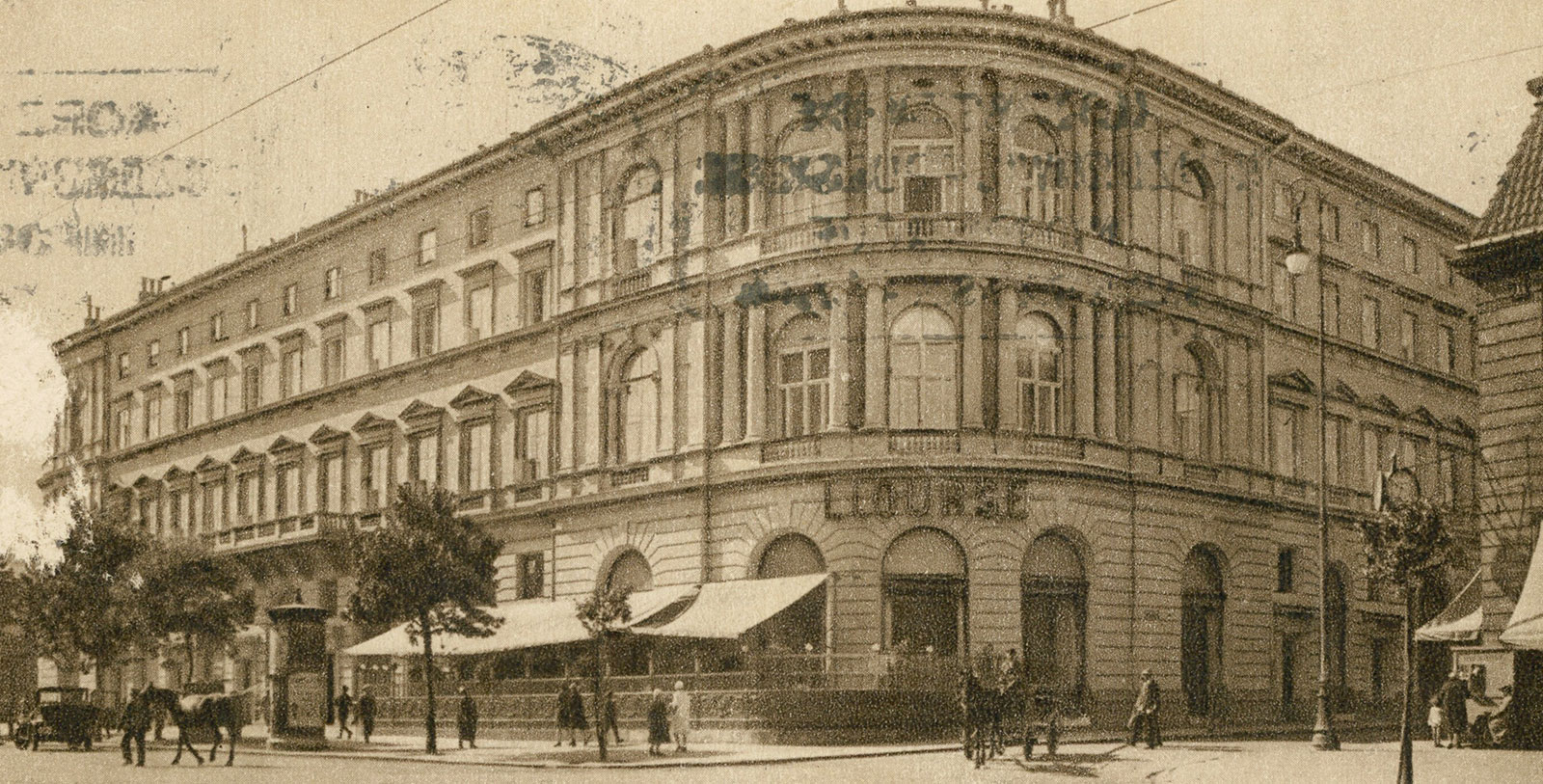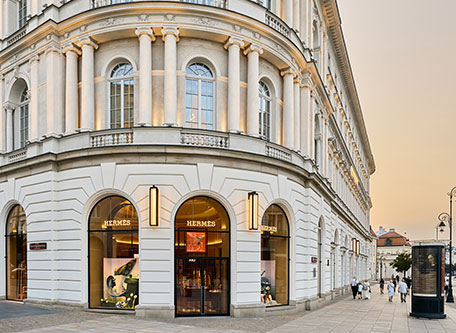Receive for Free - Discover & Explore eNewsletter monthly with advance notice of special offers, packages, and insider savings from 10% - 30% off Best Available Rates at selected hotels.
history
Discover Raffles Europejski Warsaw, which was originally designed by the renowned Italian-Polish architect, Enrico Marconi.
Raffles Europejski Warsaw, a member of Historic Hotels Worldwide since 2018, dates back to 1857.
VIEW TIMELINE
Raffles Europejski Warsaw – Two Legends. One Hotel
View the many brilliant historical images that exist of the legendary Raffles Europejski Warsaw.
WATCH NOWRaffles Europejski Warsaw dates to 1857, when it was opened to the public as a luxurious hotel and social center of Warsaw. Italian-Polish architect Enrico Marconi designed the original Hotel Europejski to be the most extravagant building of its kind in the Russian Empire. As it developed a reputation, the hotel’s glamorous parties were immortalized in the 19th-century Polish classic, The Doll, by Bolesław Prus. Artists Józef Chełmoƒski and Stanisław Witkiewicz had studios in the hotel, too, and the patisserie was a well-known gathering spot for many writers and intellectuals. In 1907, the hotel underwent a renovation to celebrate its 50th anniversary, after which it experienced a period of great success. It was even recognized as the only hotel in Poland with a luxury status from the 1920s to the 1930s.
After the World War II, the hotel was converted to a military school known as the “Military Political Academy” (Akademia Wojskowa Polityczna). Its entire redesign was spearheaded by architect Bohdan Pniewski. The remaining balustrade was added to the top floor of the hotel and the historic sections of the exterior thoroughly reconfigured. But when the military academy closed in 1954, the building was used as office space for the Polish Ministry of Transport. Two years later, it was recruited to house Jewish immigrants from the Soviet Union. The building was then transferred to Orbis, the state tourist company, which converted it back into a hotel. Orbis quickly rehired Bohdan Pniewski to spearhead the effort, with assistance provided by Bohdan Kijowicz. Upon its completion in 1962, the newly christened “Orbis Hotel Europejeski” had 273 guestrooms, 13 of which were luxurious suites.
In 1993, the heirs of the original owners filed to reclaim the hotel from the state-run Orbis chain. The case lasted for 12 years, though the plaintiffs eventually won the lawsuit. The Hotel Europejski quickly reemerged as one of Warsaw’s most sought-after vacation retreats. Raffles Hotels and Resorts then acquired the site in 2013 and initiated its own spirited series of renovations that completely revitalized it. Elements of the project were supervised by WWAA Architecture, with much of the interior design completed by Boris Kudlicka. The team saved many of the original architectural finishes, including its historic cornicing and ceiling roses. After five years of construction, Raffles finally reopened the building as the “Raffles Europejski Warsaw” to great acclaim. Now a member of Historic Hotels Worldwide, the business continues to be one of Warsaw’s most celebrated holiday destinations.
-
About the Location +
The capital city of Poland, Warsaw can trace its lineage back centuries. While the exact founding date for the municipality is unknown, most scholars believe that the first iteration of Warsaw emerged around a small fishing village on the Vistula River in the early 14th century. Duke Bolesław II of Masovia had specifically erected a fortified settlement atop the ruins of an earlier one that had been continuously raided throughout the height of the Middle Ages. The prince and his successors gradually developed the new community, overseeing the construction of such renowned structures like St. John’s Cathedral. A prosperous market economy quickly developed in the heart of early Warsaw, with all kinds of craftsmen and merchants setting up shop in the vicinity of the river. The reigning Dukes of Masovia subsequently called Warsaw their home for generations, making the city their official seat of power in 1413. To reflect Warsaw’s newfound political importance, the dukes reinforced the local defenses, even going as far as to construct a series of imposing series of thick walls around the settlement. But Warsaw’s economic prosperity continued to attract hundreds of people from across Europe, causing new neighborhoods to appear beyond the city’s ringed fortifications. The districts evolved as self-governing communities, coalescing into an autonomous borough called the “New Town.” Likewise, the center of the original settlement became known as the “Old Town.” The two experienced something of a rivalry for some time thereafter, although they gradually merged into one single community over time.
In 1529, the last Duke of Masovia died without an heir, prompting the greater Kingdom of Poland to seize control over Warsaw. Under direct Polish rule, the city nonetheless experienced an unprecedented period of expansion, with countless structures debuting all over the cityscape. The Polish kings hired renowned Italian architects to design many fantastic municipal buildings in the Old Town, giving the area its famous Italianate character. The same architects also renovated the erstwhile manor house of the former Masovian dukes, redesigning it to become the now-famous Zamek Królewski (Royal Castle). Even the surrounding fortifications received a much needed facelift, with various engineers constructing the historic Barbican citadel. The Polish monarchs subsequently lived in Warsaw for years, using the Royal Palace as their official residency. Warsaw’s political significance increased exponentially after the Kingdom of Poland entered into a personal union with the Grand Duchy of Lithuania in 1569, forming the influential Polish-Lithuanian Commonwealth. The King of Poland subsequently ruled as the Grand Duke of Lithuania, making the federation one of the most powerful on the continent. Warsaw itself soon became the capital of the new state, due to its proximity between the Commonwealth’s two major cities, Kraków and Vilnius. Many aristocrats from across the Polish-Lithuanian Commonwealth relocated to Warsaw, as such, expanding the city’s borders further south of the historic Old Town.
The fortunes of Warsaw ebbed and flowed as the prestige of the Polish-Lithuanian Commonwealth declined throughout the Early Modern era. Armies from Scandinavia and the Holy Roman Empire periodically ransacked the locale, forcing the residents to pay hefty tributes to the invaders. Perhaps the darkest moment for Warsaw at the time was the Great Northern War of the early 18th century, which saw Swedish soldiers completely occupy the city. Nevertheless, Warsaw remained an important trading center when it was not at war, with many beautiful buildings and parks opening all over the place. Unlike the earlier widespread construction work, most of the new structures reflected German-inspired design aesthetics. Among the most iconic landmarks to debut included the Zaluski Library, and Saxon Garden, and Royal Baths Park. Warsaw also continued to be the official capital of the Polish-Lithuanian Commonwealth until its collapse in the 1790s. The metropolis, thus, briefly became a part of Prussia, before Napoleon Bonaparte liberated it amid the Napoleonic Wars. The newly christened French emperor elevated Warsaw to serve as the capital for a client state—the Duchy of Warsaw—for the next several years. But the duchy, too, dissolved once Napoleon was defeated a final time at Waterloo, with the city falling under the authority of the Russian Empire.
For a time, Warsaw—and the rest of the former Kingdom of Poland—maintained some autonomy until a failed uprising challenged Russian rule in the 1830s. Warsaw still manage to thrive, though, as many prosperous factories began to dot its skyline. The arrival of the Industrial Revolution heralded another golden age for Warsaw. Its population subsequently exploded, making it the third largest city in the entire Russian Empire by the 1890s. But Russia’s sovereignty over Poland ended after World War I, with Warsaw reemerging as the capital for a newly independent Polish state in the early 1920s. Despite some attempts by the Russians to regain the region, Warsaw remained the capital for the next two decades. It quickly became a battleground in World War II, however, when German tanks entered the city in September of 1939. It greatly suffered under Nazi occupation for the next six years, with German occupational forces ruling over the conquered country from the city itself. Many residents were also victims of the Holocaust, with countless Jews forced to live in the decrepit Warsaw Ghetto. But local residents evenutally arose to resist the Nazis, epitomized by the Warsaw Ghetto Uprising in 1943, and the even larger Warsaw Uprising a year later. Upon the defeat of the second revolt, the Germans completely destroyed the city in an act of revenge. When the war came to an end as such, the natives were left to rebuild the entire city.
Poland soon became a member of the communist Eastern Bloc at the outset of the Cold War, with Warsaw serving as the capital for the Polish People’s Republic. A wave of new construction subsequently spread throughout the city, as hundreds of large, prefabricated housing projects manifested from the wreckage. Despite their dour appearance, the apartment buildings helped alleviate the surge in population that handicapped Warsaw in the aftermath of World War II. Warsaw’s former economic health returned, as well, becoming one of the most prosperous metropolitan centers within the Eastern Bloc in the process. But the reign of the Communists proved to be as severe as the Nazis, as the local populace suffered from political imprisonments and a sharp curtail on personal freedoms. The animosity toward the abuses eventually culminated with the Communist government’s overthrow in the 1980s, with the first free elections taking place in the city a decade later. Warsaw today remains one of Europe’s most admired metropolises, as well as one of the most culturally vibrant. The government in Warsaw oversees the continent’s sixth largest economy, in addition to a renowned educational and healthcare system. It is also home to numerous iconic cultural attractions, including the Pałac Pod Blachą (Copper-Roof Palace), the Pałac Kultury i Nauki (Palace of Culture and Science), and of course, the Royal Castle. In fact, all of Warsaw’s historic Old Town has even been declared a UNESCO World Heritage Site by the United Nations!
-
About the Architecture +
Designed by Italian-Polish architect Enrico Marconi in the 1850s, the Raffles Europejski Warsaw was converted into a military school and government offices before it was restored back to its former glory. Nevertheless, its original architectural details remain the same, which have since elevated the building to the status of a revered national icon in Poland. Much of the Hotel Europejski Warsaw’s historic architecture is Classic Revival in nature. Also known as “Neoclassical,” Classic Revival design aesthetics are among the most common architectural forms seen throughout Europe. Also known as “Neoclassical,” Classic Revival architecture itself is among the most common architectural forms seen throughout Europe. This wonderful architectural style first became popular in Europe in Paris, specifically among architectural students who studied at the French Academy in Rome in the late 18th century. Upon their return from the Italian Peninsula, the French architects began emulating aspects of earlier Baroque design aesthetics into their designs, before finally settling on Greco-Roman examples. Over time, the embrace of Greco-Roman architectural themes spread across the continent, reaching destinations like Germany, Spain, Great Britain, and even the Russian Empire.
As with the equally popular Revivalist styles of the same period, Classical Revival architect found an audience for its more formal nature. It specifically relied on stylistic design elements that incorporated such structural components, like the symmetrical placement of doors and windows, as well as a front porch crowned with a classical pediment. Architects would also install a rounded front portico that possessed a balustraded flat roof. Pilasters and other sculptured ornamentations proliferated throughout the façade of the building, as well. Perhaps the most striking feature of buildings designed with Classical Revival-style architecture were massive columns that displayed some combination of Corinthian, Doric, or Ionic capitals. With its Greco-Roman temple-like form, Classical Revival-style architecture was considered most appropriate for municipal buildings like courthouses, libraries, and schools. But the form found its way into more commercial uses over time, such as banks, department stores, and of course, hotels. Examples of the form can be found throughout many major cities, including London, Paris, and New York City. Architects still rely on Classic Revival architecture when designing new buildings or renovating historic ones, making it among the most ubiquitous architectural styles in the world.


























